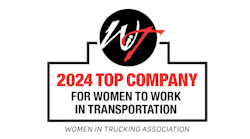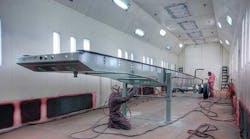Major investment by Western Trailer in blast booth has transformed paint process, attacked corrosion as part of ‘process of continuous improvement’
WESTERN Trailers—which has been manufacturing transportation equipment and trailers since 1958 from its base in Boise, Idaho—has customers all over the country.
But a majority of its customers are in the Pacific Northwest and the Rockies, and those trailers are exposed to a regular blast of magnesium chloride and salt on the roadways during harsh winters.
And that’s a primary reason why Western Trailers decided in 2011 to invest $750,000 in a blast booth from SAFE Systems Inc to enhance the paint finish on its trailers.
“It’s an ongoing process of continuous improvement,” sales manager Dan Taylor says. “We’re constantly changing things, trying to make them better, coming up with a better process and a better trailer in the end. A lot of magnesium chloride and road salt are used here, and it will just eat a trailer alive. Before we came up with our blast booth, the chemicals would get underneath the primer from rock chips. It would then work its way into the steel and you’d have blister rust.
“We heat the base metal and have the paint off gas rather than skin over. If the paint heals over and keeps the gas in, it takes longer to dry. It doesn’t cure out like it should. The more gas we get out of it, the tougher the paint job is and the longer it will last. We’ve spent a long time on it, and I’m relatively sure our competition hasn’t spent as much time on this process.”
The process also has been welcomed by customers who buy Western’s trailers and load them on ships and barges heading to Alaska.
“Customers are constantly asking us to come up with something better in that salt air,” Taylor says. “They may have a 15-year-old trailer that has only 100,000 miles on it. They spend a lot of time on those ships. They load them in the States, run them to Seattle, load them on a ship, and unload them up in Alaska. They might only get loaded four to five times a year when they’re in that cycle. So it’s not uncommon to see old trailers with virtually no miles. But they will rust away on those ships.”
Western uses the paint process on all of the trailers it manufactures: agricultural (Express belt self-unloading, Express Floor, Walking Floor, Commodity hopper), flatbeds (Classic outside frame, inside frame, Elite), forest product (drop center chip vans, Express floor, ForceSteer), refuse (drop center, express floor), curtain van, classic Hopper Flats, and military and aerospace. In nearly two and a half years, the comments from customers have validated the investment Western made.
“So far, our customers are saying the paint is holding like they’ve never seen on a trailer before—anybody’s trailer,” Taylor said. “We haven’t noticed any of the blister-rust problems. We’ve had pretty tough winters out here, so we should start to see that, and we haven’t. We have had nothing but good reviews from our customers.”
Inside the 75-foot blast booth—part of the same SAFE Systems unit used by aircraft, boat, and rail-car manufacturers—the steel undercarriage, side rails, and all steel components are subjected to a thorough round of compressed air blasting 80 grit, which is recycled through the system.
“It has a recovery floor that recovers used blast and goes into an elevator and gets cleaned to be used again,” paint shop manager Jim Rhodes says.
By blasting the metal granules into the steel, a profile is created on the steel that allows the paint to better adhere to the surface by creating a mechanical bond that “locks” the primer and paint to the metal surface, minimizing the potential for rust creep when rock chips develop.
In the pre-primer surface washing, the exposed parts are washed between 180 and 200 degrees with Dubois Securestream FRP iron phosphate, rinsed, and then sealed with Spectralink sealer. This process removes any and all foreign material. Iron phosphatizing is the chemical process that converts the surface area of iron or steel to a matrix of millions of tiny metal iron-phosphate molecules, creating a chemical bond.
“That iron phosphate crystallizes down into the grid of the blasting areas and profile, and helps the primer to heat a lot easier,” Rhodes says.
After the steel has been blasted, bathed in iron phosphate, and sealed with Dubois link technology Spectralink non-chrome sealant, surface areas are covered with LV260 epoxy primer at a thickness of approximately four to five wet mils.
The final finish is a polyurethane U-Tech 3.5 system, high-solids, and low-VOC 2K paint. This polyester formulation provides high chemical resistance, flexibility, and toughness.
An infrared drying process is used, heating the metal and then curing the paint from the inside out. Because flat surfaces absorb heat easier, in more complex areas like the undercarriage, Western can direct the infrared heat where needed. This process assures absorption of the primer and topcoat finish.
Taylor said corrosion isn’t the only benefit of the new process: “It helps to stress-relief welds, making our trailers even better. When you grit-blast or sand-blast, it helps to take the tension out of the weld.”
Western’s paint process is regularly and thoroughly tested by an outside laboratory using Gravelmeter SAE J440 GT-28, Adhesion ASTM D3359, Humidity ASTM CEMS GT-5B, Salt Spray 500 hours CEMS-GT-7D.
The beginning
When the company started in 1958, it built truck bodies in an old fire station, subsequently moving to a converted gymnasium. In the late 1960s, owner Jerry Whitehead saw a market for better trailers that could be made lighter. Using his experience in the Idaho Air National Guard, he began to incorporate aircraft aluminum into the design and manufacturing processes of a new breed of trailer.
Western started making livestock and hopper trailers in 1969, and added platform trailers the following year. In 1980, it introduced the Commodity Express trailer, then wood residual, refuse, Express Floor, chip, and other specialty trailers.
In 1982, Western opened the doors of a new, self-designed, 30,000-square-foot plant.
“Our claim to fame always has been lightweight trailers,” Taylor said. “It started when a customer came to us with a problem. He had a steel aluminum cattle trailer and wanted an all-aluminum cattle trailer because he wanted to put more cattle on. Things traveled great distance out here. Back then, it was even farther between towns.
“From there, we moved into flatbeds and hopper trailers. The hopper business was good to us up until the grain embargo. During the embargo, we were a one-line manufacturer. We still built some flatbeds but hopper trailers were selling like hotcakes, so we didn’t really push any of the markets. When the embargo hit, hopper trailers dried up overnight and the president of the company made up his mind it would never happen again—he would never get caught as a one-line manufacturer.
“We’ve always built hopper trailers, but we moved into flatbeds, and moved hard with outside-frame flatbeds for hauling lumber. We built a trailer called a hopper flatbed. It actually has hoppers in it. You can haul lumber one way and bulk products the other way. It worked well, and we sold a lot of them, and we still build them today.
“We moved into inside-frame flatbeds in the early to mid-1980s and still build them today. Woodchip trailers came along in the early 1980s, along with walking floor trailers. We then moved into the refuse trailer business. We’ve built belted potato trailers since 1972. One of the biggest potato processors is a customer and we have been their sole supplier for over 20 years.”
Taylor said Western expects to manufacture 1000 trailers this year.
“Business for us has been robust,” he said. “It’s everything we thought it would be when we wrote the business plan for the year—and maybe a little bit more. We expected business to come up and be up for us in the 15% to 25% range, and it’s come back like that. We’ve got salesmen stationed all over the country, and that helps. It’s not just one area. We sell trailers all over the US and Canada.
“We’re very fortunate to be a company that does a whole bunch of things. We could be building hoppers one week and switch over the next week and be building belt trailers. We do have one line that runs pretty consistently on flatbeds. One line is a mixed line we can do anything on. Those bays could be building outside-frame flatbeds one week, and two weeks later hopper trailers, and three weeks after that garbage trailers. It’s whatever we need to balance in there.
“We’ve always had a wonderful product mix here. It’s a little bit of everything we do that keeps us busy.”
Western now occupies a campus in Boise that has over 22 acres and nearly 200,000 square feet of space. Over half this space is devoted to the manufacturing process, and the balance to an aftermarket heavy-duty parts sales warehouse, truck and trailer service, new trailer sales, and a business office. Western also has service, parts, and trailer sales centers in Portland and Albany, Oregon, and in Spokane and Seattle, Washington.
The company has 310 employees who are guided by a group of managers and supervisors with an average tenure of service of 18½ years.
Western has hired 35 workers since June 1, and is in the process of hiring another 20.
The company also is planning three major initiatives:
- It is rebuilding one of the punch presses and installing all-new controls to increase the speed of panel-punching.
- “That’s a large investment,” Taylor said. “We’re working on another press to punch our posts for sheet and post trailers. So it will singly punch posts. In the past, the panel press has punched both panels and posts. In order to get more production, we’ll do that.”
- It is building a 56,000-square-foot warehousing facility on a seven-acre spread two miles from the main facility. Right now, the warehouse is actually in two different leased buildings.
- It has just opened a new dealership in Vancouver, Washington, is building a new one near Seattle and has overhauled the location in Spokane.
- Western’s plan to stress innovation andcontinuousimprovement is rooted in the last five items of its Core Principles and Values:
- We will continuously seek better methods, superior tools, and improved products and services: Focus on processes.
- We will experiment with better ways and products and then evaluate the results for further improvement: Embrace scientific thinking (PDSA: Plan, Do, Study, Act).
- We have a passion for success, so we search for improvement everywhere: Think systematically.
- We will develop a deep understanding of our customers’ problems and needs: Create value for the customer.
- Experimentation sometimes creates failure, but we will learn from our mistakes and push forward.
“It’s continual, constant improvement,” Taylor said. “A lot of what we do here is continue to innovate. Our tag line or motto or company byline is, ‘Delivering quality, innovative transportation solutions.’ You just have to do that out West.” ♦
__________________
Click here to view all large photos and captions
for Western Trailers paint process










